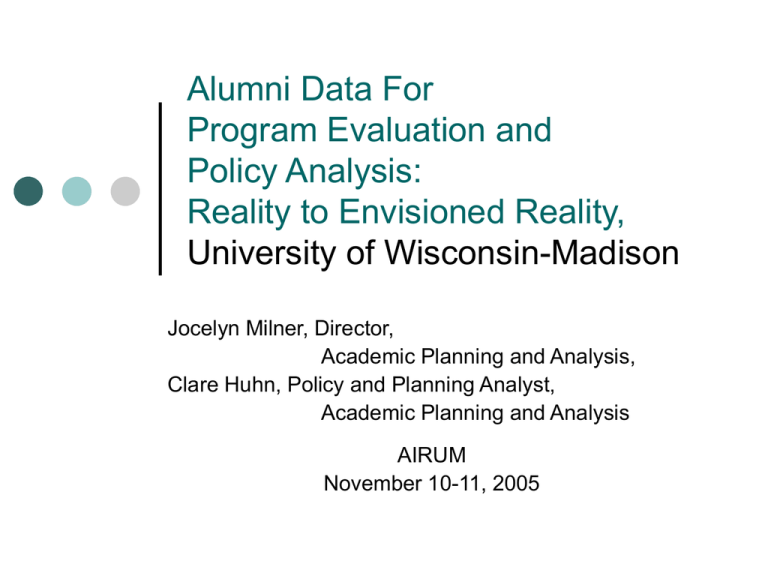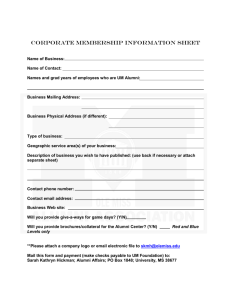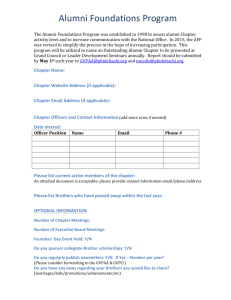AIRUM Presentation - Academic Planning and Institutional Research
advertisement

Alumni Data For Program Evaluation and Policy Analysis: Reality to Envisioned Reality, University of Wisconsin-Madison Jocelyn Milner, Director, Academic Planning and Analysis, Clare Huhn, Policy and Planning Analyst, Academic Planning and Analysis AIRUM November 10-11, 2005 Acknowledgements Our Wisconsin Alumni Association (WAA) collaborators Heidi Zoerb, Sr. Marketing and Research Manager (until 11/05) Angie Nash, VP for Information Services Peter Spear, Provost (until 11/05) Paula Bonner, President of WAA Funded in part by grants from the UW-Madison Assessment Fund (2004-05 and 2005-06) 2 UW-Madison/WAA Alumni Data Project Outline Context, ideas, and bigger ideas Phase I – Feasibility Study (did these ideas have a future?) Phase II – Development (making the ideas work) Comments and advice from you 3 UW-Madison/WAA Alumni Data Project Research on Alumni A long and rich history Under-developed 4 Development and giving Services to alumni, effective communications strategies Learning outcomes, engagement, academic and curricular planning, recruiting UW-Madison/WAA Alumni Data Project Starting Assumptions, Now Assertions Information about alumni is important to academic programs for assessment and evaluation (External stakeholders expect we know) 5 Gaps in the available information are worth making an effort to fill UW-Madison/WAA Alumni Data Project Idea – Alumni Profile Build a “profile” of alumni information for each academic program Base it on unit record data Include degree information, addresses, employment, continued engagement, perceived value of a UW-Madison degree, evident value of a UW-Madison degree 6 UW-Madison/WAA Alumni Data Project Alumni Profile Level: Bachelors Major: Jurassic Studies 1-5 years 6-10 out years out % Female 50% 42% % Minority 12% 8% % Living in WI 45% 36% % Providing employment info 100% 73% % Employed, by occupation, by sector 100% 98% % Employed in occupation related to major 68% 87% % Who agree that UW-Madison education “made a difference” 100% 100% % Continued engagement (through WAA) 77% 95% % Ever made a donation 3% 75% 7 UW-Madison/WAA Alumni Data Project Bigger Idea – If we have a unit record alumni data set, then we have a powerful resource for analysis and for serving our public accountability needs. 8 UW-Madison/WAA Alumni Data Project Public “Accountability” Use data, analysis to counter assumptions and mis-information (“brain drain”) Measuring Up (national report card) Accreditation: HLC-NCA, ABET, and most others AAU Institutional Data Committee – what do graduates do? 9 UW-Madison/WAA Alumni Data Project Public “Accountability” HEA (S.1932) “Requires institutions to report to the DoE information on employment placement of graduates and graduates that enroll in graduate education as gathered from such sources as alumni surveys, student surveys, NSSE, state data systems, other relevant sources.” (from 10/28/05 AAU summary) 10 UW-Madison/WAA Alumni Data Project Questions? What do graduates do after college? Did their education make a difference to them? (private interest) Did their education make a difference to the community? (public interest) 11 UW-Madison/WAA Alumni Data Project External / Internal External utility (IR office, provost’s office, external affairs) aggregated analysis at the institutional or school/college level Internal utility (school/college, department or program level) Alumni Profiles, lists of alumni 12 UW-Madison/WAA Alumni Data Project The timing was right (Spring 2004) UW-Madison gave up on PS-Advancement The Registrar’s Office gave post-graduation records to WAA and UW Foundation WAA invested in on-line collection interface and robust data base Potential arose for unified alumni records Alumni records now separated from student records 13 UW-Madison/WAA Alumni Data Project 14 UW-Madison/WAA Alumni Data Project Outline Context, ideas, and bigger ideas Phase I – Feasibility Study (did these ideas have a future?) Phase II – Development (making the ideas work) Comments and advice from you 15 UW-Madison/WAA Alumni Data Project Phase I – Feasibility Study Can we actually produce a prototype Alumni Profile, use unit record alum data for analysis? What data elements are held centrally? Where are the gaps? Who are the data custodians? Are they willing partners? Can the data sources can be linked? Can they be used analytically? 16 UW-Madison/WAA Alumni Data Project Project Goals Expand the collection of information on UW-Madison alumni to include more elements of interest for program evaluation and academic program development. Store the information in a data base structure that makes is accessible for analysis and aggregate reporting. Make use of the enriched alumni data sources to develop regular reports and analytic resources to support program faculty and staff and others for academic program evaluation and development. of provide students, prospective students and their families with information on the post-graduation experiences of UW-Madison students. to describe the value of a UW-Madison degree to the people of Wisconsin, state and federal legislators, news media, accreditors, and other external audiences. Make use of the enriched alumni data sources to conduct research and analysis related to academic issues and initiatives. 17 UW-Madison/WAA Alumni Data Project Slide Credit: Joanne Berg, AVC Enrollment Mgmt 8/05 Enrollment Management Continuum Prospective Applicants Applicants For Admissions Admitted Applicants Enrolled Students Alumni Graduates PreCollege Program Participants Each box represents points along the continuum when source data is collected. Source data for individuals represented by boxes above the line are stored in a central data source. All reports should be generated from source data. PreCollege Program Prospects “...tracking, internal program planning and assessment, information for development, grant writing, recruitment...” Change 2004 18 UW-Madison/WAA Alumni Data Project What we have. What we want. Fragmented alumni data with limited use for programmatic or analytical purposes. Potential to expand the WAA alumni data collection system. 19 Unified collection system structured for operational and programmatic uses. UW-Madison/WAA Alumni Data Project Slide Credit: Joanne Berg, AVC Enrollment Mgmt 8/05 Information Flow Distributed Entry Collection Storage Audit and Analysis (who knows the data best *) Reporting Official reporting Internal reporting 20 UW-Madison/WAA Alumni Data Project Central, shared system *Data Custodians *IR Collecting alumni information It’s given voluntarily. Persuade by: service delivery (transcripts, career advising, free email) alumni directory searches alumni involvements (reunions) ***department/program encouragement*** 21 UW-Madison/WAA Alumni Data Project Available data elements UW-Madison Registrar’s Office: Degree records, student records, demographics Wisconsin Alumni Association (WAA) and UW Foundation 22 Alumni addresses, employment information, spouses, engagement (WAA membership, donations, etc) UW-Madison/WAA Alumni Data Project Alumni Profile 1-5 years 6-10 out years out % Female % Minority % Living in WI % Providing employment info % Employed, by occupation, by sector % Employed in occupation related to major % Who agree that UW-Madison education “made a difference” % Continued engagement (through WAA) % Ever made a donation 23 UW-Madison/WAA Alumni Data Project Alumni Profile Prototype All bachelors major programs All masters major programs All doctoral major programs 24 See handout UW-Madison/WAA Alumni Data Project Data Availability and Gaps Degree information 100% Alumni addresses >90% (NCOA) Employer <50% Job title (free form) ~50% Occupation title pick list – new UW-Madison “made a difference”, “related to my major” – unconnected, scattered survey data WAA engagement, UW Foundation donor - 100% 25 UW-Madison/WAA Alumni Data Project Policy Analysis Geographic Distribution of Alumni Evidence of workforce contributions to the WI economy Evidence of added value of a university education How programs compare with each other 26 UW-Madison/WAA Alumni Data Project Geographic Distribution of Alumni Other Midwest (not incl. WI) •24% Overall 13% WI Resident students 47% Non-resident students Wisconsin •51% Overall 69% WI Resident students 11% Non-resident students Northeast •8% Overall 3% WI Resident students 17% Non-resident students New Information! Pacific •7% Overall 6% WI Resident students 11% Non-resident students (includes AK and HI) West •3% Overall 3% WI Resident students 3% Non-resident students 27 UW-Madison/WAA Alumni Data Project See handout. South •7% Overall 6% WI Resident students 10% Non-resident students Analytical Questions Top 10 lists by program…. % living in WI % engaged with the university (WAA) % ever made a donation % providing employment information 28 UW-Madison/WAA Alumni Data Project Top 10 List – Job Titles Provided % Providing Job Title Information School/ College Major Code Major Name ALS 639 Meat and Animal Science 78 EGR 175 Civil and Environmental Engineering 77 ALS 247 Dairy Science 75 ALS 054 Agronomy 72 ALS 027 Agricultural Economics 72 NUR 712 Nursing 70 BUS 004 Accounting 69 BUS 882 Risk Management and Insurance 69 BUS 009 Actuarial Science 67 ALS 814 Poultry Science 67 29 UW-Madison/WAA Alumni Data Project Top 10 List – Donors % Who have ever Donated $ School/ College Major Code Major Name EGR 175 Civil and Environmental Engineering 53 ALS 247 Dairy Science 51 BUS 004 Accounting 49 ALS 639 Meat and Animal Science 45 ALS 036 Agricultural Engineering 45 EGR 711 Nuclear Engineering 44 BUS 882 Risk Management and Insurance 44 BUS 009 Actuarial Science 43 ALS 027 Agricultural Economics 43 EGR 148 Chemical Engineering 40 30 UW-Madison/WAA Alumni Data Project Phase I – Findings WAA, UW Foundation, Registrar are custodians “IR” office and WAA developed a willing and energetic partnership Address, demographic, engagement information is available; gaps in employment information, value perceptions Produced a prototype Alumni Profile for all majors Student and alumni data can be linked and used analytically, but within narrow limits 31 UW-Madison/WAA Alumni Data Project Outline Context, ideas, and bigger ideas Phase I – Feasibility Study (did these ideas have a future?) Phase II – Development (making the ideas work) Comments and advice from you 32 UW-Madison/WAA Alumni Data Project To move ahead … 1. 2. We need more alumni to put their information in the WAA collection system We need to collect more kinds of information in a structure that can be used analytically 33 UW-Madison/WAA Alumni Data Project How to move ahead? 1. 2. Convince schools/colleges/departments to use the WAA system Expand and improve the WAA data collection and data base structure for broad purposes 34 UW-Madison/WAA Alumni Data Project Convince the schools/colleges/departments Academic units are pivotal in directing graduating students to use the WAA collection interface Get them to share shadow systems Need their input on expanded collections 35 UW-Madison/WAA Alumni Data Project Barriers Schools/colleges/departments want control Concerns about just-in-time delivery of information Concerns about privacy for alumni One-size doesn’t fit all Time and money 36 UW-Madison/WAA Alumni Data Project Incentives Academic units want services The WAA already provides free, just-intime services Under-used by academic units 37 UW-Madison/WAA Alumni Data Project WAA Services Alumni directory look-up Career services Lists of alumni by program By name, who works at Ford Motor Co, who lives in Singapore age, gender, race/ethnicity, geographic region, with spousal information http://www.uwalumni.com/lists/ 38 UW-Madison/WAA Alumni Data Project 39 UW-Madison/WAA Alumni Data Project 40 UW-Madison/WAA Alumni Data Project 41 UW-Madison/WAA Alumni Data Project Expanded WAA Collection Employment information re-design to support analysis Use standard occupation/sector formats to allow for benchmarking Design and add survey-type questions Unit record format Connects to alum and student records 42 UW-Madison/WAA Alumni Data Project Employment Collection Structure Possible taxonomies: Occupation: Standard Occupational Classification System (SOC) Sector: North American Industry Classification System (NAICS) US Census Current Employment Question See Handout. 43 UW-Madison/WAA Alumni Data Project Modified from V. Borden, NDIR, V126, 2005 Impact Indicators for Bachelors Degree Holders Percent of Program Alumni Indicator <=2 years out Employed full time Pursing a graduate or professional degree Completed a graduate or professional degree Pursing other continuing education Employment is related to their undergraduate studies (somewhat or directly related) Education prepared them well for current job (somewhat or very well) First job after graduation was related to undergraduate major(s) (somewhat or strongly) UW-Madison education “made a positive difference” in graduate’s life (agree or strongly agree) 44 UW-Madison/WAA Alumni Data Project 3-5 years out 6-10 years out >10 years out Progress Report Sept 2005 July 2006 As planned: Active conversations with colleagues in 4 of 13 schools/colleges Design for employer, occupation, sector collection progressing Survey questions in design 45 Unexpected: Improving UW-Madison’s external image identified as a high priority Provost transition – how will leadership make a difference? Partner transition – personnel change at WAA UW-Madison/WAA Alumni Data Project Comments from You Your questions for us? What is your experience with alumni data collections, reporting, and analysis? Your ideas for reducing barriers, overcoming resistance? Are there data sets or sources we’ve missed? 46 UW-Madison/WAA Alumni Data Project Selected References and Further Reading 1. 2. 3. 4. 5. Borden, V.H.M. 2005. Using Alumni Research to Align Program Improvement with Institutional Accountability. New Directions for Institutional Research. V126: 61-72. Cabrera, A. F., D.J. Weerts, and B.J. Zulick. 2005. Making an Impact with Alumni Surveys. New Directions for Institutional Research. V126: 5-18. Ewell, P.T. 2005. Alumni Studies as Instruments of Public Policy: The US Experience. New Directions for Institutional Research. V126: 19-30. Pearson, J. 1999. Comprehensive Research on Alumni Relationships: Four Years of Market Research at Stanford University. New Directions for Institutional Research. V101: 5-21. Pettit, J. 1999. Now What Should You Do? New Directions for Institutional Research. V101: 101-105. 47 UW-Madison/WAA Alumni Data Project UW-Madison / WAA Alumni Data Project For more information: http://wiscinfo.doit.wisc.edu/obpa/Alumni/alumni.htm Jocelyn Milner – jlmilner@wisc.edu Clare Huhn – chuhn@vc.wisc.edu 48 UW-Madison/WAA Alumni Data Project


